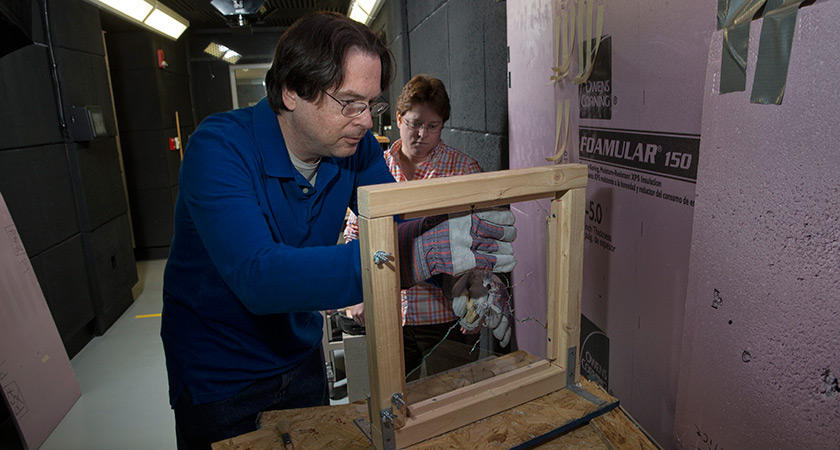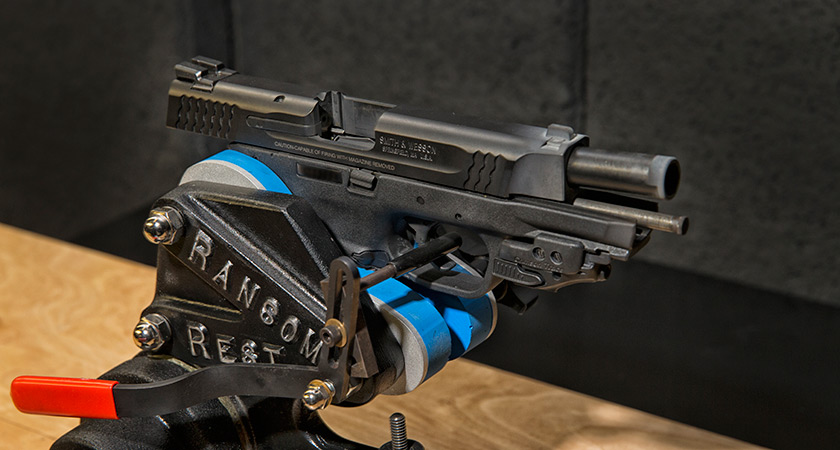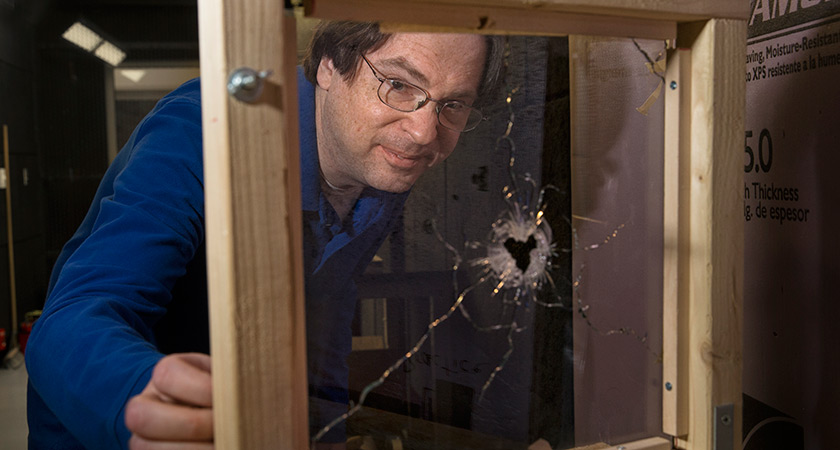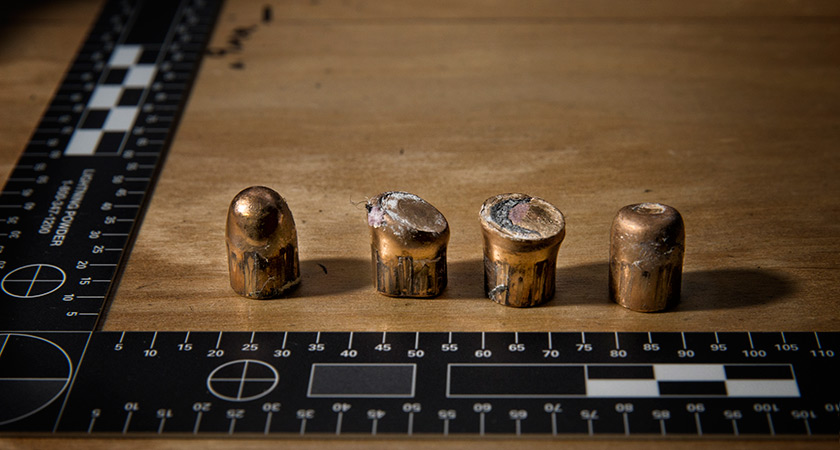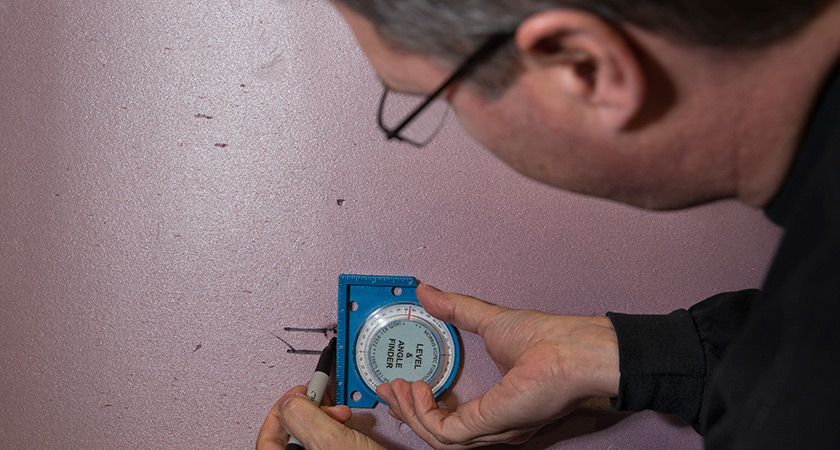Path of destruction
Study tracks deflection of bullets through glass
By Bonnie Blankinship
Drs. Allen Rogel and Kate Dellenbusch, in the Department of Physics and Astronomy , are normally found studying the stars. But this year they are bringing their sights down to earth to help forensic investigators solve crimes. The two are working with Gary Wilgus, special agent supervisor with the Bureau of Criminal Investigation, to learn how bullets striking glass at an angle are deflected.
“The idea for the study sprang from an actual homicide investigation where bullets were fired through double pane window glass, which is found in about 99 percent of residential buildings,” Wilgus said. “We know that there’s a significant deflection when shots are fired through glass or drywall or other substrates, but no one had studied it. Our quest is to see how accurately we can place the general location of the shooter based on the data from this study.”
Understanding the deflection of bullets through single and double pane glass will help investigators trace back the initial path of the bullet.
“This will improve the accuracy of our crime scene shooting reconstruction,” Wilgus said.
“This will improve the accuracy of our crime scene shooting reconstruction,” Wilgus said.
Rogel and Dellenbusch spent about 40 days last fall in the shooting range at the BCI facility on campus with Wilgus, firing hundreds of rounds through glass panes into foam boards and painstakingly marking, measuring and photographing the results for later analysis.
The study comprised both single- and double-pane glass and .45-caliber and 9mm regular and hollow point bullets.
Today, Rogel and Dellenbusch are just as painstakingly mapping and measuring on millimeter graph paper every shot fired and entering the results in a database, working side by side at a large table in Overman Hall, surrounded by bullet-ridden foam boards.
“We’re going to be doing some serious number-crunching when we get the database complete,” Rogel said. That part of the process presents an opportunity for student engagement.
Wilgus worked with Dr. Jon E. Sprague, director of the Ohio Attorney General’s Center for the Future of Forensic Science, on a proposal to obtain one of the center’s grants and find faculty experts with whom to partner. Part of the center’s mission is to “advance the profession and practice of the forensic sciences through cutting-edge research.”
Dellenbusch and Rogel, both astronomers, were intrigued and responded to Sprague’s email requesting physics expertise. They were surprised by the lack of existing research on the topic. There is much more research about bullets going into windshields and tempered glass, Rogel found, “so our goal is to expand upon the literature.”
Crime scene analysts traditionally use a standard plus- or minus-5 degree deflection angle when calculating the trajectory of bullets hitting glass at an angle, but that is based on an old study that used much thicker glass than is typically found in homes and smaller, slower bullets than are usually used in crimes today.
“The former study was optimized for maximum deflection,” Rogel said.
Interestingly, when a shot is fired perpendicular or nearly perpendicular to glass, there is virtually no deflection and the glass shards scatter straight out, even with double panes. But larger angles seem to cause a significant change in the bullet’s trajectory after passing through the glass, while the glass shards still spray out perpendicular to the glass.
Although conducting the study centered on their physics expertise, Rogel and Dellenbusch became “full-service researchers” for the project.
“We designed and constructed it from the ground up,” Dellenbusch said. “We made many trips to Home Depot for lumber and supplies and duct tape.”
The first step was designing and building the bench that would hold the glass, and the frames that would support each sample. The researchers then installed foam boards on the sides and back of their experiment site in the shooting range at BCI. After passing through the foam board, the bullets were trapped in a box filled with Kevlar vest panels, which trapped the bullets for collection and later examination.
“You need two entry points in order to calculate the deflection,” Rogel said. These were the glass and then the foam board. In the case of the double-paned glass, they were actually three impact points, he added.
In cases where the bullet cannot be found lodged, its direction can be determined both by the glass shards and the “beveling” that occurs on the opposite side of the glass from where it was impacted.
The local company Bowling Green Glass and Mirror might have been surprised by the researchers’ order of 750 square feet of glass cut into 1-square-foot sections, the two noted humorously. Luckily, the company also provides disposal of broken glass, of which the study produced large amounts. In some cases the bullets’ impact virtually “turned it back into sand,” Dellenbusch said.
Rogel called upon his experience working with cold stained glass in devising a way to hold the glass panes. Any pressure on them would have caused stress that could have distorted the results. That old standby, masking tape, proved sufficient to hold the glass panels into the frame without warping them.
The guns were positioned and clamped into a mount, operated by Wilgus, which prevents movement during firing.
“We spent an inordinate amount of time making sure everything was aligned and stayed in alignment, because even a slight change could significantly throw off our results,” Rogel said. The positioning was rechecked and verified after each series of shots.
The researchers marked each entry point with duct tape to be able to distinguish them. That was only one part of the tedious process. They began each day by shooting several rounds to settle the gun into the mount. Then, to verify the alignment and provide a calibration for later measurements, they fired three shots into the foam board, and another 10 rounds through either single or double glass mounted at a fixed angle, followed by a final alignment check shot. After each shot, the locations of bullet impact were marked, measured and photographed, glass was cleaned up and the experiment was reset. The full process was repeated for five or six angles per combination of gun and bullet type. They averaged three data runs of a 10-shot group plus calibration shots a day.
“By collecting so much data we could drive down the statistical uncertainty,” Rogel said.
“It was slow and methodical, and they were fantastic to work with,” Wilgus said. He also expressed his gratitude to Sprague and the center for their support.
“The marriage between the Center for the Future of Forensic Science and the University has been great,” Wilgus said. “It has made our study possible and I hope we can continue to publish our results. But also for its internships and externships and professional development. I’ve already had members of our department decide to come to Bowling Green to get their master’s in forensic science.”
Updated: 12/02/2017 12:35AM

